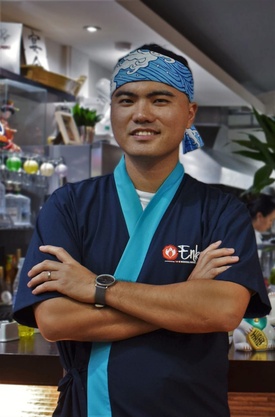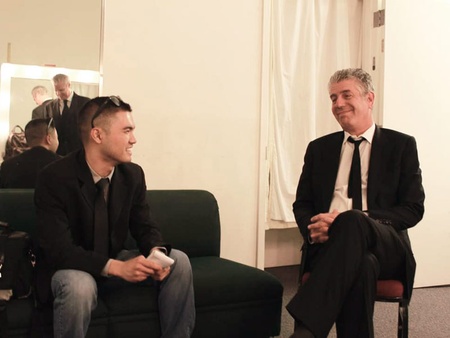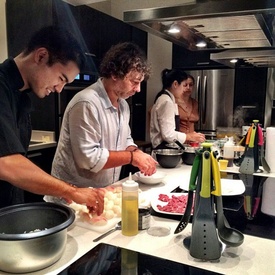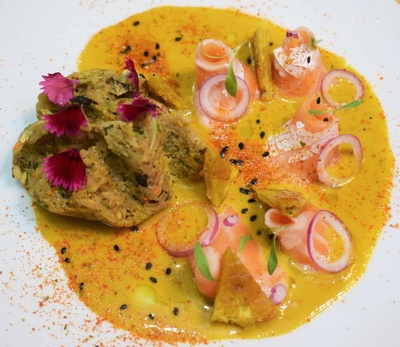The career of a chef usually has several routes that make their training experience an adventure. In 2002, Gastón Acurio, the most famous Peruvian chef, started a television program that charted a path for many young people who wanted to study cooking. The show was called Culinary Adventure and it was a tour of the gastronomic proposals from all over Peru.

At that time, Masaki Uyema was 11 years old and did not yet know that he would be a chef, although he was already curious about gastronomy, an interest that arose at family gatherings that were held at his aunt Sumi's house. He grew up knowing Creole cuisine, the first thing prepared by the Japanese migrants who arrived in Peru at the end of the 19th century, and when he left Union School he thought about choosing another vocation.
“I wanted to be a journalist,” says Masaki, another career for the curious, who remembers an episode that reflects his culinary concern. “One day my aunt Sumi couldn't come to prepare the lomo saltado. I had seen her cooking and she had all the ingredients ready, everyone wanted to eat, so I did it.” Dare. You need to have it to stand in front of the stove and then in front of the diner's eyes waiting for a positive review.
“I realized that cooking could make people happy,” says Masaki, with a smile, who studied at Le Cordon Bleu and to learn more about Nikkei cuisine, he began to practice in restaurants like Edo, Sansushito and other sushi restaurants. bars with the characteristic itamae suit that he wears until now. “At school there was no Nikkei cooking course, only international cuisine where Japanese was mentioned,” recalls the young chef, who soon continued his culinary adventure outside of Peru.
Travel, eat, learn
His first stop was the United States, where he arrived through an exchange that took him to the Ritz Carlton hotel in Florida. There he learned international cuisines and understood the harsh reality of Peru, where cooking is a poorly paid career. “As an intern in Palm Beach they paid me as if I were American,” Masaki recalls, explaining that in Lima many of the cooking positions do not reach the level of what a student earns abroad.
Masaki alternated cooking with his old love of journalism, collaborating with the Peruvian magazine Provider a la carte , where he had a column called “Chronicles of an Intern.” During those years he met chef Anthony Bourdain, famous for his television show No Reservations . From the interview that 1 did with him in 2013, he learned a lesson that continues in his mind: travel, learn about other cuisines to return to your country and apply everything you have learned.

After his American experience, which led him to cook in San Francisco, Masaki stopped in Panama, Colombia and Guatemala. Bourdain's lesson was learned, so much so that the young chef had the opportunity to represent Panama in the San Pellegrino Young Chef 2016 competition, with a Japanese-influenced dish that he called “Mutü”, a slow-cooked bacon in different alliáceas. and Japanese spices. Before, in San Francisco, at the Puerto 27 restaurant, he had shown his ancestral influence, in a dish he called causa maki, a Peruvian dish (la causa) with Japanese technique (in the form of rolls).
cooking lessons

He spent three years in Panama that allowed him to understand that fusion, that letter of introduction of every migrant, is a value for the chef. He also understood that the mission of a chef is to give value to his environment. There he worked with products from native communities and in Guatemala he learned to revalue local products that are often not recognized by people from the same area.
“I saw similarities with what happens in Peru,” says Masaki, who returned to Lima to open the Enkai restaurant in Jesús María, where he experiments with many national ingredients, especially with jungle products. One of his sources of inspiration was Brazilian chef Alex Atala, who uses Amazonian cuisine with refined culinary techniques. “We realized that, except for the restaurants of the great Nikkei chefs, all the others are almost the same sushi bars,” he says in plural because this is a family business that he started with his wife.
At Enkai, which means party, celebration and banquet, it seeks to give people happiness through a different cuisine, in a neighborhood that identifies the Nikkei community, the San Felipe residential area, surrounded by trees like in an urban jungle, and where There is room for original dishes such as the causa maki that will be presented in the United States, and for new creations such as the kani patacones, made with salmon, avocado, togorashi and chili charapita; or the yaki juane, with chicken, squid and shrimp, kombu seaweed, salmon tiradito in smoked tiger's milk, patacones, pickled onion, charapita chili togarashi and edible flowers.
Learning is the adventure
It opened a little over a year ago and since then Enkai has already shown that it seeks to be more than just a sushi bar. Coconut ceviche, chanchi bao (bacon in steamed bread) and rice pizza are part of its cover letter. “We wanted to open here to give back for everything we have received,” says Masaki who, in the adventure of having his own restaurant in a district where there are more than 10 Nikkei food restaurants, received other lessons from migration.
“We saw that there are many Venezuelans who are working in kitchens but who are not well paid. We seek to help them have a better quality of life,” he says. And Masaki does not forget that he learned from many people who were generous to him, such as Toshiro Konishi, Mitsuharu Tsumura and Iván Matsufuji. “Peruvian chefs have a great responsibility to society through food,” he says at 28 years old.
Enkai also seeks to ensure that more people know and value Nikkei cuisine, the kind that evolved from Peruvian Creole cuisine to fusion with Japanese ingredients and that in a short time has made a name for itself internationally based on Japanese techniques and inputs. from all over Peru. “That is our mission, what transcends us,” he says without losing his smile or taking his eyes off his kitchen, to which he jumps back to serve the new client who arrives at Enkai to be part of his culinary adventure.
Note:
1. A la carte supplier (Edition 41, April 2013)
© 2019 Javier García Wong-Kit







